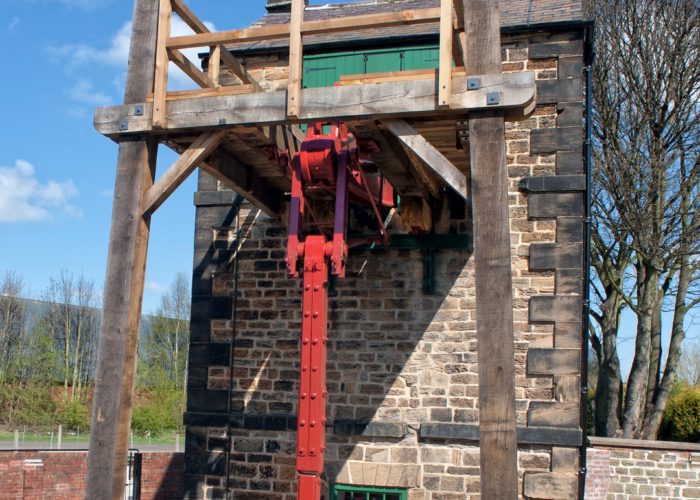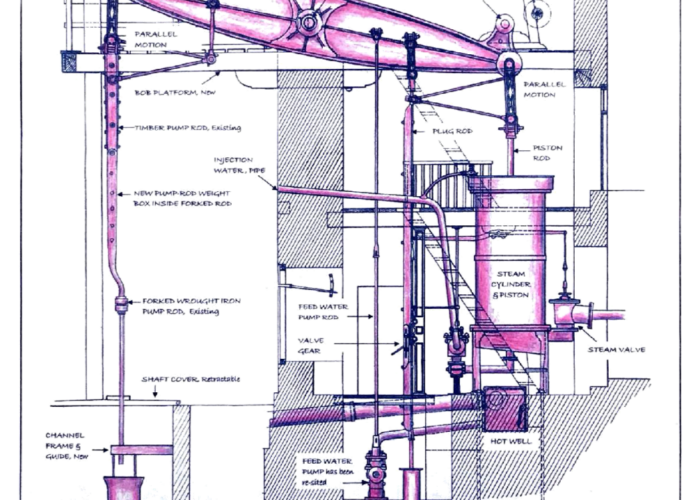Newcomen Beam Engine
Theme: The impact of industry, Economic and technological revolution
The atmospheric engine was invented by Thomas Newcomen in 1712. It was the first machine to be powered by steam and was largely used to pump water out of mines. Hundreds of these engines were made and used all over Britain and Europe in the 1700s. They became known simply as the Newcomen Engine and helped pave the way for the Industrial revolution.
Before the 1700s, there were very few machines and most work was powered by hand. The energy of horses and oxen was harnessed to pull ploughs, wagons, and mills. Water was also used as an important source where possible. But work was relatively slow and could usually only be carried out in daylight or at certain locations. The Newcomen engine was the first commercially viable machine to be fuelled by steam. It was designed to pump water out of coal mines, which enabled miners to go deeper and tap into further seams of coal, tin and other minerals.
By 1725 the Newcomen engine was a common site in mines across Britain. Its design went largely unchanged until the 1770s when John Smeaton made a number of improvements. Around the same time, while working at Glasgow University, James Watt was asked to repair a model Newcomen steam engine. Realising the engine was inefficient, he developed a revolutionary new design that would help a steam engine run faster and use less fuel.
With his business partners Matthew Boulton and William Murdoch, Watt went on to further refine his revolutionary design, so that steam engines could not only efficiently pump water, but drive machinery in paper, cotton, flour and iron mills, textile factories, distilleries, canals, waterworks and even drive steam locomotives. These extraordinary developments transformed the British landscape and the lives of its people, and became known as the Industrial revolution.
This Newcomen Engine, at Elsecar Heritage Centre in Yorkshire, was built in 1795, to pump water from Elsecar New Colliery. The Engine ran until 1923 when it was finally replaced by electric pumps. The Newcomen Beam Engine is the only one of its kind in the world to remain in its original location. It is considered one of the the world’s most important piece of industrial heritage.
Did you know..?
At its peak, this engine could pump up to 600 gallons of water – about 20 baths full – per minute.
Barnsley Museums worked with digital artists, and a local primary school, to create a projection map of the Newcomen Beam Engine, telling its story and showing how it works. Find out more here.
Use our Education activities to investigate this object and the Industrial Revolution further.
Highlights:
- Using objects, artworks and other sources to find out about the past
- How to create an animated projection map
- Greenscreening
And much more…
Sources & acknowledgements
This object description and its related educational resources were researched and written by our team of historians and education specialists. For further information see the item’s home museum, gallery or archive, listed above.
- Related resources
-
Did you know..?
At its peak, this engine could pump up to 600 gallons of water – about 20 baths full – per minute.
-
Education overview
You can access a range of teachers resources related to this object and more on our education page.
Please also see our glossary of terms for more detailed explanations of the terms used.
-
Curatorial info
- Originating Museum: Barnsley Museums, Elsecar Heritage Centre
- Production Date: 1795
-
Use this image
You can download this image for personal and educational use but please take note of the license type and rights holder information.
- Rights Holder: Barnsley Museums, Elsecar Heritage Centre
- License Type: All Rights Reserved







